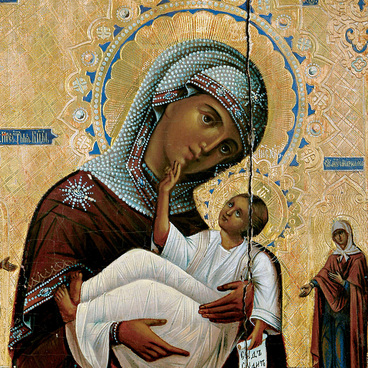The icon was created by priest Matfey Yakovlev in 1829. The image is a replica of the miraculous icon Our Lady of Murom located in Ryazan. Transportation of the Holy image from Ryazan to Murom in September 1829 was quite an event. It was followed by a prayer service and a large sacred procession.
The citizens of Murom lost this icon in antiquity. Information about it is found in the Tale of St. Basil of Ryazan. St. Basil (rus. Vasily) was a bishop of the Orthodox Church in the 13th century. He was unjustly accused of lechery and expelled from Murom. St. Basil settled in Ryazan and took the icon of Our Lady of Murom there. The saint traveled on a mantle along the waters of the Oka River against its course. In his hands he held the image of Our Lady in his hands. This journey is considered one of the miracles performed by the icon. Early information on the cult of the image of Our Lady of Murom had been lost in Murom until the 18th century.
Nevertheless, documentary evidences of several icons of Our Lady of Murom were preserved in the city. All of them date back to the 18th and 19th centuries. For example, in the Catherine’s chapel of the Nativity Church there was the image of Our Lady of Murom. It was created by an icon painter Alexander Kazantsev in 1730. According to the Inventory as of 1768, another icon of Our Lady of Murom was stored in the Vvedensky Church of the Resurrection Monastery.
After the victory over Napoleon army in 1812, Russia underwent a patriotic upsurge. The nobility took interest in folk treasures and antiquities. At this time, the veneration of Our Lady of Murom received a boost. Murom citizens stated their willingness to celebrate this icon. They laid a chapel in its honor at the city’s Cathedral of the Nativity of the Blessed Virgin Mary.
The presented icon had become one of the main relics of the city cathedral. In 1831, it was adorned with a precious frame created with the money of Murom citizens. The icon has a chased silver setting, decorated with acanthus motifs on the upper and lower edges; attached stars and rhinestones, and a pearl riza. By the end of the 1820s, the Murom icon had been fully recognized by the Murom community as a local historical relict. When the original icon, kept in Ryazan disappeared, this copy acquired an extrinsic value.
The citizens of Murom lost this icon in antiquity. Information about it is found in the Tale of St. Basil of Ryazan. St. Basil (rus. Vasily) was a bishop of the Orthodox Church in the 13th century. He was unjustly accused of lechery and expelled from Murom. St. Basil settled in Ryazan and took the icon of Our Lady of Murom there. The saint traveled on a mantle along the waters of the Oka River against its course. In his hands he held the image of Our Lady in his hands. This journey is considered one of the miracles performed by the icon. Early information on the cult of the image of Our Lady of Murom had been lost in Murom until the 18th century.
Nevertheless, documentary evidences of several icons of Our Lady of Murom were preserved in the city. All of them date back to the 18th and 19th centuries. For example, in the Catherine’s chapel of the Nativity Church there was the image of Our Lady of Murom. It was created by an icon painter Alexander Kazantsev in 1730. According to the Inventory as of 1768, another icon of Our Lady of Murom was stored in the Vvedensky Church of the Resurrection Monastery.
After the victory over Napoleon army in 1812, Russia underwent a patriotic upsurge. The nobility took interest in folk treasures and antiquities. At this time, the veneration of Our Lady of Murom received a boost. Murom citizens stated their willingness to celebrate this icon. They laid a chapel in its honor at the city’s Cathedral of the Nativity of the Blessed Virgin Mary.
The presented icon had become one of the main relics of the city cathedral. In 1831, it was adorned with a precious frame created with the money of Murom citizens. The icon has a chased silver setting, decorated with acanthus motifs on the upper and lower edges; attached stars and rhinestones, and a pearl riza. By the end of the 1820s, the Murom icon had been fully recognized by the Murom community as a local historical relict. When the original icon, kept in Ryazan disappeared, this copy acquired an extrinsic value.




